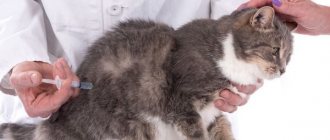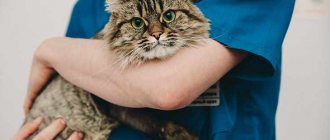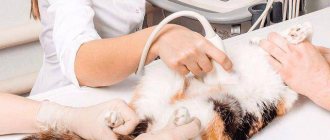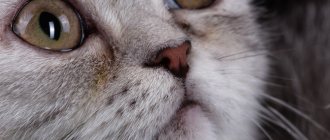In most cases, the first thing an owner needs to do when bleeding is detected in a pregnant cat in the loop area is to show the animal to a veterinarian. It is important to know that bleeding can be both normal and pathological. The owner’s main task is to give the cat maximum attention throughout pregnancy in order to notice dangerous symptoms in time, but making an accurate diagnosis and further treatment should only be trusted to a veterinarian.
Norm or deviation?
In the first 3 weeks from the start of pregnancy, a cat may have pinkish or brown discharge from the loop, which can be confused with blood. In this way, unfertilized eggs are gradually removed from the body (from the uterus). They are dense, viscous secretions that even look like leeches. Further, until the very birth, a healthy pregnant cat should not have any bleeding or discharge, with the exception of the birth process. For this variant of the norm, the following criteria are:
- The discharge appeared directly during childbirth, after the end of active contractions.
- The color of blood is scarlet or red-brown.
- Bleeding lasts no more than 8-10 minutes.
- The total volume of blood discharge does not exceed 2 tablespoons.
- There is no strong unpleasant odor.
Any other characteristics of bleeding or its appearance at an earlier stage (especially in the second trimester of pregnancy) are a sign of physiological disturbances in the process of bearing offspring, which can be dangerous for the cat and future kittens. Possible pathological causes include:
- Miscarriage, which can occur due to premature death of the fetus or injury to the abdominal area, in response to which the uterus reacts by rejecting the embryos;
- Frozen pregnancy, when the development of fetuses stops and they remain in the uterine cavity, decomposing and causing inflammatory processes. This is one of the most dangerous symptoms during cat pregnancy, since the unborn offspring provokes intoxication of the body. As a result, a failure of various body systems may occur, but the kidneys react especially quickly to this situation.
- “Natural selection”, when even in the early (and sometimes late) stages of pregnancy the body rejects embryos with pathologies, which can also be accompanied by bleeding.
- Placental abruption, which is accompanied by the appearance of dark brown discharge and poses a danger to the cat and future offspring. If detachment occurs near the end of pregnancy (8-9 weeks), the offspring has a better chance of survival. In this case, urgent measures are usually not taken, and the cat remains under observation until the birth process.
- Inflammatory processes in the uterus, other organs of the reproductive or urinary system.
Gestational age and bleeding
If a pregnant cat is bleeding, it is important to pay attention not only to the amount of discharge, but also to the stage of pregnancy. The norm is a complete absence of bleeding for the entire gestation period (9 weeks).
Sometimes a pregnant cat bleeds in a small amount (about 40 ml) before giving birth. Such bleeding should last no longer than 10 minutes, have a completely liquid consistency, normal odor and scarlet color. Also during this period, yellowish or greenish discharge without an unpleasant odor may leak from the loop
The appearance of blood in the early stages of pregnancy (up to 3 weeks) of a cat indicates possible pathologies and often this phenomenon ends in spontaneous abortion. At this time, only pinkish watery discharge is acceptable, which characterizes the process of formation of a mucus plug in the cervix.
If the bleeding has an unpleasant odor, a greenish impurity, a brown or black tint, then you should immediately show your pet to a veterinarian.
Cat behavior
Cats themselves are clean animals. Any discharge during pregnancy (including blood) may remain unnoticeable to the owner, since the pet will lick everything. In this case, remaining blood in the tail area and constant licking of this area may be a warning sign. Some owners perceive frequent licking of the loop as an indicator of the pet's cleanliness, but in reality, in this way the animal is trying to reduce the pain of the inflamed area. In addition, you should pay attention to other alarming symptoms:
- lack of appetite;
- lethargy and apathy;
- depressed state.
If the bleeding is profuse enough, then traces of it may remain on the floor, in the tray or on pieces of furniture. This means that the pet is unable to cope with self-care due to a large amount of discharge or due to a state of weakness that does not allow maintaining hygiene, so the pet should be taken to a specialist.
Normal discharge in a cat before giving birth
A few days before the onset of contractions (usually from 63 to 65 days of pregnancy), the body begins to prepare for childbirth. Normally, the mucus plug comes off about a day before the onset of contractions. However, as the experience of owners shows, the mucous plug can come off several weeks before birth.
Note! The mucus plug may be streaked with blood as the blood supply allows it to renew and enlarge as the kittens grow.
In any case, if you notice that there is pink discharge left on your cat’s fur, most likely these are traces of a mucus plug. The pigmentation of the mucus plug can vary from clear to creamy to greenish in color. The volume of mucus released is an individual indicator. Most owners do not monitor the process of the mucus plug coming out, since it is very small and remains in the litter tray after urination.
What to do
If blood is detected in a pregnant cat, prompt attention to a veterinarian is often critical. The life of the offspring and the animal itself may depend on this. The doctor will conduct a thorough examination with ultrasound and complex tests. Based on the results obtained, he will advise what is best to do next: remove or maintain the pregnancy. Depending on its duration, he may also offer:
- waiting for a natural birth in combination with supportive drug treatment;
- C-section;
- stimulation of premature birth.
In addition, restorative therapy or antibiotics are prescribed in case of inflammatory processes.
Attention! In the event of fetal death, the only way to save the cat is to induce premature labor or surgical intervention, supplemented by subsequent restorative treatment.
Causes of bleeding
Discharge may appear immediately before childbirth. Most often, there is nothing to worry about, the color of such discharge is rather brown, this is considered the norm. However, if you are concerned and unsure about the time limit, it is better to take your pet to the veterinarian. In the middle of pregnancy, brown discharge may be a sign of placental abruption or indicate the death of the kittens.
If placental abruption occurs around nine weeks, then the cat is closely monitored, an ultrasound is performed and the birth begins. If bleeding begins before the 8th week, you may have to resort to induction of labor or a caesarean section to save the life of the offspring.
As you can see, it is best to immediately show the animal to a veterinarian if discharge is detected. Contact us at the vet, our specialists will do everything possible to ensure that neither the cat nor her kittens are harmed during pregnancy.
POLAR BEAR
The veterinary clinic in Nizhny Novgorod "White Bear" provides all types of services for cats and dogs.
Conducts any examinations and tests in its own veterinary laboratory; the clinic operates a veterinary ambulance for animals and a 24-hour veterinarian is on call at home. Agreement on the processing of personal data
Public offer
SITE MENU
- About the clinic
- Price list for veterinary clinic services
- Treatment
- Services
- Price list for veterinary clinic services
- Vetapteka
- Contacts
- Site Map
CONTACTS
- Nizhny Novgorod st. Vyatskaya 7
- 8 (831) 437-25-27
- [email protected]
Precautionary measures
Simple precautions will help to significantly reduce the risk of bleeding in a cat during pregnancy and carry her healthy offspring. For this it is important:
- Prepare the body for conception with a balanced diet and vitamin supplements to support immunity (after consultation with a veterinarian).
- Get your required vaccinations on time.
- Avoid active and active games during pregnancy, during which injury to the abdominal area is possible.
- Ensure a comfortable room temperature and absence of drafts.
- Give your cat enough attention to notice changes in behavior and health in time.
Veterinarian advice for bleeding in a pregnant cat: video
conclusions
In order for a cat to give birth to healthy offspring, you need to monitor its condition.
We repeat that if any of these signs appear, you must immediately report it to the nearest available veterinary office to help your pet endure this important but difficult process. Careful monitoring of your own furry will help not only to avoid problems with childbirth (and pregnancy in general), but also to tie your pet even closer to you, because the animal will be grateful to you for this.
Dangerous diseases
Brown discharge from a cat's eyes
Bloody and green discharge with a specific odor in a cat during pregnancy always indicates a pathological process, which is why additional symptoms appear. The reasons may be different: inflammation of the reproductive system, placental abruption, fetal death, etc. In some cases, this indicates diseases that require urgent treatment.
Vaginitis
Inflammation of the vagina. A diagnostic sign is that the cat begins to lick itself quite often, hiding the discharge. This makes diagnosing the disease difficult. A mild form can be cured with douching, a severe form can be treated with antibiotics.
Endometritis
Inflammation of the uterus. It is caused by intrauterine infection, as a result of which the animal can give birth to weakened or premature babies, who sometimes even die. Acute endometritis, if left untreated, leads to the death of the cat. And as a result of chronic endometritis, hydrometra can develop. The secreted secretion itself can be of different shades, any consistency and smell.
Hydrometer
Accumulation of fluid, exudate, and secretions of the uterine glands in the uterine cavity. As a result, the uterus swells. Scanty or spotting discharge is possible. It often develops against the background of chronic endometritis. Emergency treatment is necessary, otherwise the cat may die.
Hematometer
Occurs in case of uterine injury or inflammation. Blood accumulation occurs. During pregnancy, a cat will have bloody discharge from the uterine cavity.
Pyometra
An inflammatory disease of the uterus, as a result of which pus accumulates in it. Due to hormonal imbalance or pathogenic flora entering the cavity, endometritis begins to develop.
Schematic drawing of pyometra in a cat
Pyometra occurs in two forms:
- open. The resulting pus leaves the uterine cavity to the outside. The owner can easily detect such departments and begin urgent treatment;
- closed. With this form, pus accumulates inside, thereby inflating the uterus. Diagnosing the disease in this case is much more difficult. It is necessary to observe the behavior of a pregnant cat. Lethargic and apathetic state, fever, loss of appetite, profuse thirst, the cat often begins to lick itself, often urinates, while breathing is heavy.
Mr. Cat Explains: Safe Slime Formations
The appearance of pink discharge may be noted after mating, this is normal.
You should carefully observe the abundance of mucous formations; if a foreign odor develops or blood is separated, you need to seek help from a veterinary hospital.
Until the cervix closes completely, unfertilized eggs can be seen leaving the genitals in the form of a brown discharge. This is considered the norm, as it indicates the mummification of dead, decomposing embryos, which occurs with complete sterility in the womb. If an organ is infected, an inflammatory process begins.











